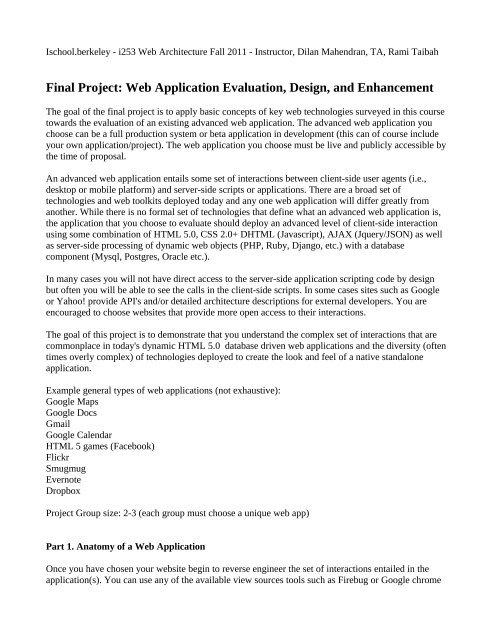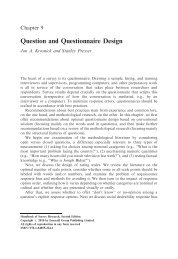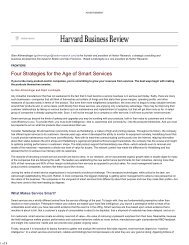Final Project: Web Application Evaluation, Design, and ... - Courses
Final Project: Web Application Evaluation, Design, and ... - Courses
Final Project: Web Application Evaluation, Design, and ... - Courses
Create successful ePaper yourself
Turn your PDF publications into a flip-book with our unique Google optimized e-Paper software.
Ischool.berkeley - i253 <strong>Web</strong> Architecture Fall 2011 - Instructor, Dilan Mahendran, TA, Rami Taibah<br />
<strong>Final</strong> <strong>Project</strong>: <strong>Web</strong> <strong>Application</strong> <strong>Evaluation</strong>, <strong>Design</strong>, <strong>and</strong> Enhancement<br />
The goal of the final project is to apply basic concepts of key web technologies surveyed in this course<br />
towards the evaluation of an existing advanced web application. The advanced web application you<br />
choose can be a full production system or beta application in development (this can of course include<br />
your own application/project). The web application you choose must be live <strong>and</strong> publicly accessible by<br />
the time of proposal.<br />
An advanced web application entails some set of interactions between client-side user agents (i.e.,<br />
desktop or mobile platform) <strong>and</strong> server-side scripts or applications. There are a broad set of<br />
technologies <strong>and</strong> web toolkits deployed today <strong>and</strong> any one web application will differ greatly from<br />
another. While there is no formal set of technologies that define what an advanced web application is,<br />
the application that you choose to evaluate should deploy an advanced level of client-side interaction<br />
using some combination of HTML 5.0, CSS 2.0+ DHTML (Javascript), AJAX (Jquery/JSON) as well<br />
as server-side processing of dynamic web objects (PHP, Ruby, Django, etc.) with a database<br />
component (Mysql, Postgres, Oracle etc.).<br />
In many cases you will not have direct access to the server-side application scripting code by design<br />
but often you will be able to see the calls in the client-side scripts. In some cases sites such as Google<br />
or Yahoo! provide API's <strong>and</strong>/or detailed architecture descriptions for external developers. You are<br />
encouraged to choose websites that provide more open access to their interactions.<br />
The goal of this project is to demonstrate that you underst<strong>and</strong> the complex set of interactions that are<br />
commonplace in today's dynamic HTML 5.0 database driven web applications <strong>and</strong> the diversity (often<br />
times overly complex) of technologies deployed to create the look <strong>and</strong> feel of a native st<strong>and</strong>alone<br />
application.<br />
Example general types of web applications (not exhaustive):<br />
Google Maps<br />
Google Docs<br />
Gmail<br />
Google Calendar<br />
HTML 5 games (Facebook)<br />
Flickr<br />
Smugmug<br />
Evernote<br />
Dropbox<br />
<strong>Project</strong> Group size: 2-3 (each group must choose a unique web app)<br />
Part 1. Anatomy of a <strong>Web</strong> <strong>Application</strong><br />
Once you have chosen your website begin to reverse engineer the set of interactions entailed in the<br />
application(s). You can use any of the available view sources tools such as Firebug or Google chrome
Ischool.berkeley - i253 <strong>Web</strong> Architecture Fall 2011 - Instructor, Dilan Mahendran, TA, Rami Taibah<br />
developers tools to begin your forensic analysis. Once you have analyzed the complete set of<br />
interactions you must provide a software/data flow diagram <strong>and</strong> site map of the application or set of<br />
applications. In conjunction with the software/data flow diagram <strong>and</strong> site map provide a user<br />
interaction flow of the application. What types of user interactions is the website author trying to<br />
achieve? What techniques <strong>and</strong> technologies are used to achieve these dynamic interactions?<br />
Part 2. <strong>Application</strong> <strong>Design</strong><br />
Once you have described the set of interactions in detail, compare <strong>and</strong> contrast the web application<br />
framework(s) used (<strong>Web</strong>kit, Prototype, Django, Ruby etc.) <strong>and</strong> specific web technologies to other<br />
possible frameworks <strong>and</strong> combination of web technologies that can be used to achieve similar dynamic<br />
interactions. Why have the particular site authors chosen to build their web application in their given<br />
framework <strong>and</strong> set of technologies? What alternative frameworks or new web technologies would you<br />
propose to improve the site's usability <strong>and</strong> performance?<br />
Part 3. <strong>Application</strong> Enhancement<br />
Take one dynamic interaction from the website application you have reverse engineered <strong>and</strong> reengineer<br />
that interaction in a functional prototype. How would you improve the interaction to make the site more<br />
usable <strong>and</strong> efficient? The goal is not to reengineer the entire complex set of interactions but one simple<br />
interaction. This can entail redesigning page navigation through DHTML <strong>and</strong> CSS or rewriting an<br />
AJAX prefetching component to make image loading more efficient. You must demonstrate how your<br />
enhancement differs <strong>and</strong> improves upon the production/beta website application you have chosen.<br />
----------------------<br />
Group Proposals Due 10/17/2011 <strong>and</strong> will be listed on course website.(send proposals to<br />
dilanm@ischool <strong>and</strong> taibah@gmail<br />
Each group must provide a detailed report (5-10 page + flow diagrams) for Parts 1-3 along with a<br />
functioning web prototype of the reengineered web interaction component(s). <strong>Final</strong> report due EOD<br />
last class meeting.<br />
Each group must give a 10-15min presentation of the website application evaluated,describing its<br />
interaction technologies, <strong>and</strong> the enhancement proposed with a prototype demonstration. Presentations<br />
will take place during the last two class meetings. (Presentation schedule TBD.)<br />
<strong>Final</strong> <strong>Project</strong> is 40% of course total grade.
















